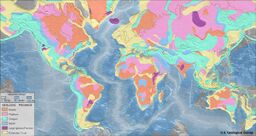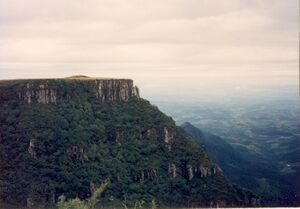Paraná and Etendeka traps
Topic: Earth
 From HandWiki - Reading time: 3 min
From HandWiki - Reading time: 3 min
| Paraná and Etendeka traps | |
|---|---|
| Paraná and Etendeka Plateau or Paraná and Etendeka Province | |
 The Paraná and Etendeka traps shown as dark purple spot on the geologic map of South America | |
| Location | Brazil , Uruguay, northwest Namibia & southwest Angola |
| Part of | Paraná Basin |
| Offshore water bodies | Southern Atlantic |
| Area | 1,500,000 km2 (580,000 sq mi) |
| Formed by | Break-up of Pangaea |
| Geology | Serra Geral Formation |
| Age | Early Cretaceous 138-128 Ma |
| Last eruption | Barremian |

The Paraná-Etendeka Large Igneous Province (PE-LIP) (or Paraná and Etendeka Plateau; or Paraná and Etendeka Province) comprise a large igneous province that includes both the main Paraná traps (in Paraná Basin, a South American geological basin) as well as the smaller severed portions of the flood basalts at the Etendeka traps (in northwest Namibia and southwest Angola). The original basalt flows occurred 136 to 132 million years ago. The province had a post-flow surface area of 1,000,000 square kilometres (390,000 sq mi) and an original volume projected to be in excess of 2.3 x 106 km³.[1][2]
Geodynamics
The basalt samples at Paraná and Etendeka have an age of about 132 Ma, during the Valanginian stage of the Early Cretaceous.[3] Indirectly, the rifting and extension are probably the origin of the Paraná and Etendeka traps and it could be the origin of the Gough and Tristan da Cunha Islands as well, as they are connected by the Walvis Ridge (Gough/Tristan hotspot). The seamounts of the Rio Grande Rise (25°S to 35°S) that go eastwards from the Paraná side[4][5] are part of this traps system.[6]
Description
Interpretations of geochemistry, including isotopes, have led geologists to conclude that the magmas forming the traps and associated igneous rocks originated by melting of asthenosphic mantle due to the arrival of a mantle plume to the base of Earth's lithosphere. Then much of the magma was contaminated with crustal materials prior to their eruption. Some plutonic rocks related to the traps escaped crustal contamination reflecting more directly the source of the magmas in the mantle.[7]
A type of rock called ignimbrite is found in some parts of the traps indicating explosive volcanic activity. The Paraná Traps possibly contains the site of the single largest explosive volcanic eruption known in Earth's history.[8]
See also
- Geology of Paraguay
- Geology of Uruguay
- Paraná Basin
- Uruguayan dyke swarms
References
- ↑ Courtillot, Vincent E.; Renneb, Paul R. (January 2003). "Sur l'âge des trapps basaltiques (On the ages of flood basalt events)". Comptes Rendus Geoscience 335 (1): 113–140. doi:10.1016/S1631-0713(03)00006-3. Bibcode: 2003CRGeo.335..113C.
- ↑ Fodor, R.V.; McKee, E.H.; Roisenberg, A. (1989). "Age distribution of Serra Geral (Paraná) flood basalts, southern Brazil". Journal of South American Earth Sciences 2 (4): 343–349. doi:10.1016/0895-9811(89)90012-6. Bibcode: 1989JSAES...2..343F.
- ↑ Stewart, Kathy; Turner, Simon; Kelley, Simon; Hawkesworth, Chris; Kirstein, Linda; Mantovani, Marta (1996). "3-D, 40Ar-39Ar geochronology in the Paraná continental flood basalt province". Earth and Planetary Science Letters 143 (1–4): 95–109. doi:10.1016/0012-821X(96)00132-X. Bibcode: 1996E&PSL.143...95S.
- ↑ O'Neill, C.; Müller, R. D.; Steinberger, B. (2003). "Revised Indian plate rotations based on the motion of Indian Ocean hotspots". Earth and Planetary Science Letters 215 (1–2): 151–168. doi:10.1016/S0012-821X(03)00368-6. Bibcode: 2003E&PSL.215..151O. http://www.earthbyte.org/people/dietmar/Pdf/Muller-etal-hotspots-Geology1993.pdf.
- ↑ O'Connor, J. M.; le Roex, A. P. (1992). "South Atlantic hot spot-plume systems. 1: Distribution of volcanism in time and space". Earth and Planetary Science Letters 113 (3): 343–364. doi:10.1016/0012-821X(92)90138-L. Bibcode: 1992E&PSL.113..343O.
- ↑ Brazilian 'Atlantis' found - Geologists have announced the discovery of what has been dubbed the 'Brazilian Atlantis', some 900 miles from Rio., Donna Bowater, The Daily Telegraph, 7 May 2013
- ↑ Owen-Smith, T.M.; Ashwal, L.D.; Sudo, M.; Trumbull, R.B. (2017). "Age and Petrogenesis of the Doros Complex, Namibia, and Implications for Early Plume-derived Melts in the Paraná–Etendeka LIP". Journal of Petrology 58 (3): 423–442. doi:10.1093/petrology/egx021. Bibcode: 2017JPet...58..423O.
- ↑ Scott E. Bryan; Ingrid Ukstins Peate; David W. Peate; Stephen Self; Dougal A. Jerram; Michael R. Mawby; J.S. Marsh; Jodie A. Miller (2010). "The largest volcanic eruptions on Earth". Earth-Science Reviews 102 (3–4): 207–229. doi:10.1016/j.earscirev.2010.07.001. Bibcode: 2010ESRv..102..207B. https://eprints.qut.edu.au/40259/1/c40259.pdf.
Further reading
- "The Parana-Etendeka Province". Large Igneous Provinces: continental, oceanic, and planetary flood volcanism. Geophysical Monograph. 100. Washington, DC: American Geophysical Union. 1997. pp. 217–245. http://myweb.uiowa.edu/dpeate/downloads/Parana-review.pdf.
External links
- "EMAGE: East Antarctic Margin Aeromagnetic and Gravity Experiment". Alfred Wegener Institute for Polar and Marine Research. http://www.awi.de/en/research/research_divisions/geosciences/geophysics/projects/magnetics/emage/.
 |
 KSF
KSF